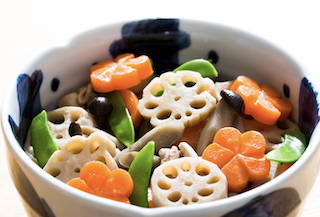Nimono:
Exploring the Tradition and Elegance of Japan's
Simmered Delicacies
Nimono (煮物) is a traditional Japanese dish that involves simmering ingredients in a seasoned broth. The term "nimono" itself translates to "simmered things" in English, reflecting the cooking method that defines this culinary style. Nimono is a staple in Japanese cuisine, known for its savory and gentle flavors, and it showcases the depth and subtlety of Japanese cooking techniques.
Origins and Significance
Nimono typically includes a variety of ingredients such as vegetables, tofu, meat, or fish. These ingredients are slowly simmered in a mixture of dashi (a broth made from seaweed and bonito flakes), soy sauce, sake, mirin (a sweet cooking rice wine), and sugar. The choice of ingredients often changes with the seasons, reflecting the Japanese culinary emphasis on seasonal eating.

Tradition and History
The practice of simmering ingredients in a liquid has been a part of Japanese cuisine for centuries. It likely started as a practical way to cook ingredients thoroughly and make them more digestible while enhancing their natural flavors. Over time, as cooking methods evolved and new ingredients became available through trade, nimono developed into a refined dish that could be adapted for both everyday meals and special occasions.
Historically, nimono dishes were appreciated for their ability to be stored for a period of days without spoiling, thanks to the preserving qualities of the soy-based simmering liquid. This made them particularly valuable in times before modern refrigeration.

Cultural Significance
In Japanese culture, nimono is more than just a cooking technique; it is an expression of the philosophy of "umami," which is the fifth taste sensation characterized as savory or meaty. The slow simmering process allows the flavors of the dashi, soy, and mirin to penetrate deeply into the ingredients, creating dishes that are rich in umami.
Nimono dishes are often served at traditional Japanese celebrations and are a common part of meals during the New Year (Osechi Ryori), where each ingredient and the style of cooking carry symbolic meanings meant to invoke health, prosperity, and happiness for the coming year.
Varieties
There are many regional variations of nimono across Japan, each using local ingredients and unique combinations of seasonings. Some popular examples include:
Chikuzenni: Chicken and vegetable nimono from Kyushu.
Oden: A winter hot pot dish with various ingredients like boiled eggs, daikon radish, and fish cakes.
Furofuki Daikon: Simmered daikon radish served with a miso-based sauce.
Nimono embodies the care and thoughtfulness of Japanese cooking, where the intrinsic flavors of the ingredients are drawn out and celebrated, making it a beloved part of the cuisine's rich and diverse heritage.



